Nursing Report: Pathophysiology, Diagnosis, MG's Heart Failure
VerifiedAdded on 2020/01/23
|11
|3032
|87
Report
AI Summary
This nursing report focuses on the case of patient MG, who presented with congestive heart failure. The report begins with an introduction to nursing care and the specific health challenges faced by MG, including the pathophysiology of her condition, which includes symptoms of swollen legs and breathlessness. It then details the risk factors associated with cardiovascular disease, such as high blood pressure and unhealthy lifestyle choices, and the complications MG experienced, including her medical history of Type 2 Diabetes. Three nursing diagnoses are presented: managing high blood pressure, stabilizing breathing, and reducing leg swelling. For each diagnosis, the report outlines goals, nursing interventions (including monitoring blood pressure, creating a relaxing environment, and elevating the patient's legs), and the rationale behind these interventions. The report emphasizes the importance of patient cooperation, empathy, and appropriate medical care to improve MG's health outcomes. The report concludes with a call for continued monitoring and adherence to medical advice to reduce further complications.
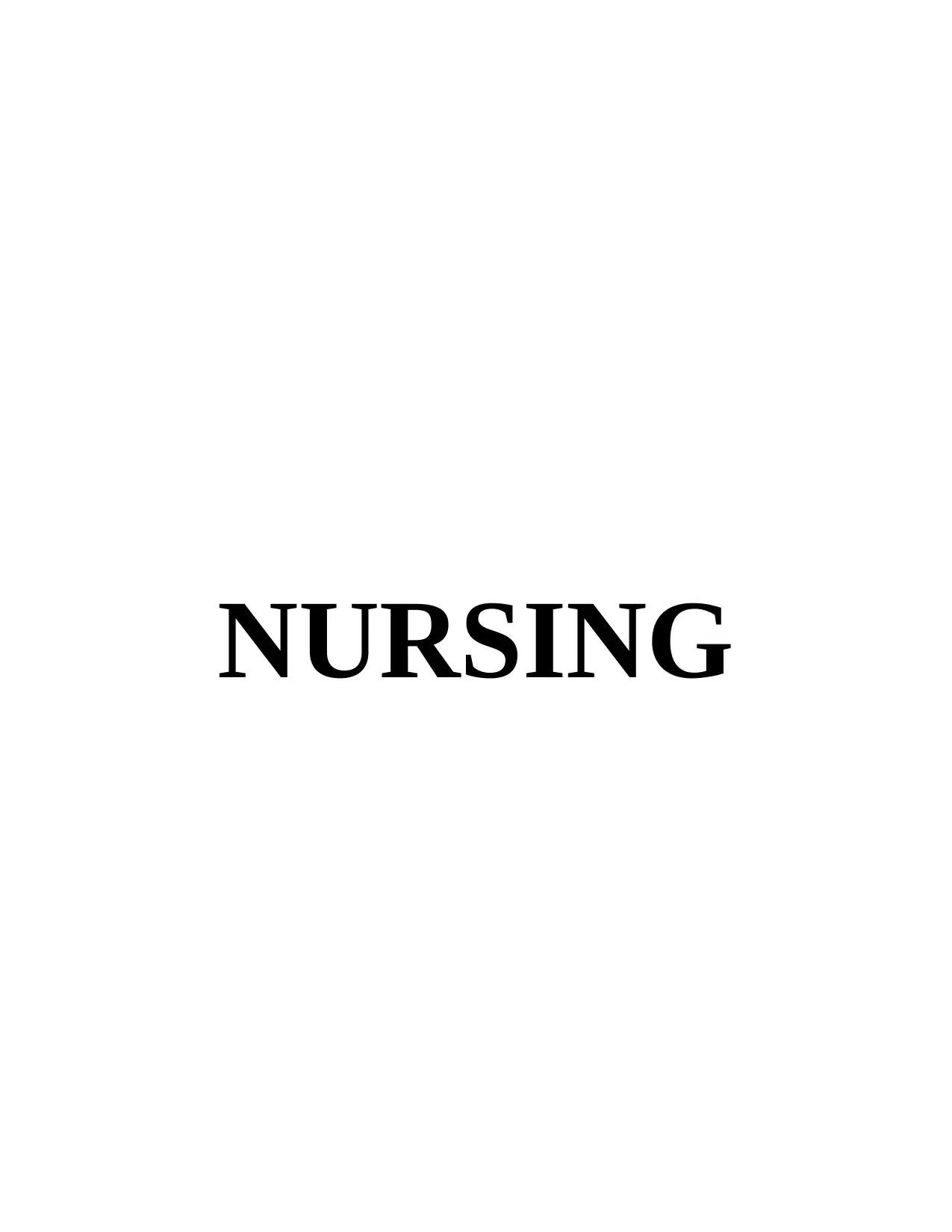
NURSING
Paraphrase This Document
Need a fresh take? Get an instant paraphrase of this document with our AI Paraphraser
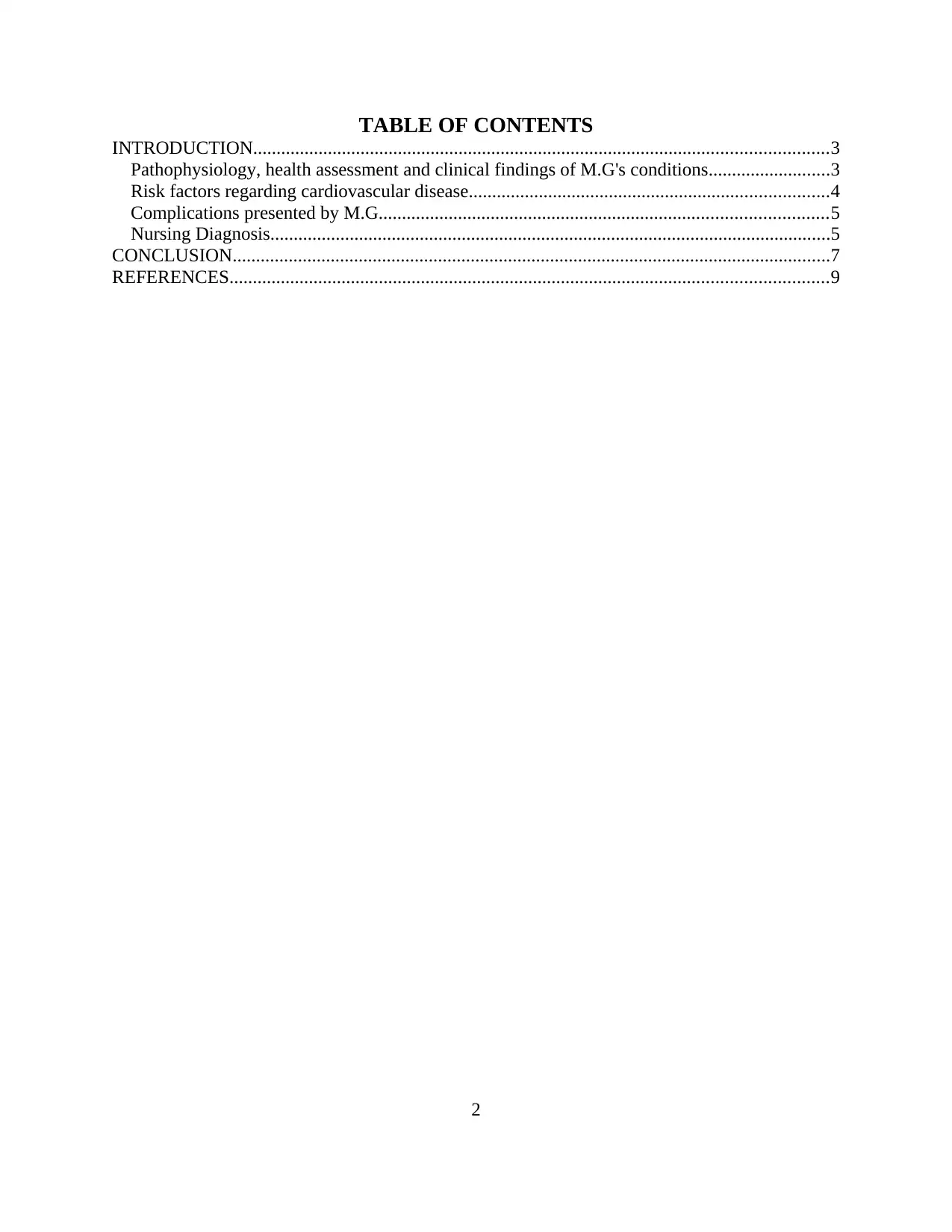
TABLE OF CONTENTS
INTRODUCTION...........................................................................................................................3
Pathophysiology, health assessment and clinical findings of M.G's conditions..........................3
Risk factors regarding cardiovascular disease.............................................................................4
Complications presented by M.G................................................................................................5
Nursing Diagnosis........................................................................................................................5
CONCLUSION................................................................................................................................7
REFERENCES................................................................................................................................9
2
INTRODUCTION...........................................................................................................................3
Pathophysiology, health assessment and clinical findings of M.G's conditions..........................3
Risk factors regarding cardiovascular disease.............................................................................4
Complications presented by M.G................................................................................................5
Nursing Diagnosis........................................................................................................................5
CONCLUSION................................................................................................................................7
REFERENCES................................................................................................................................9
2
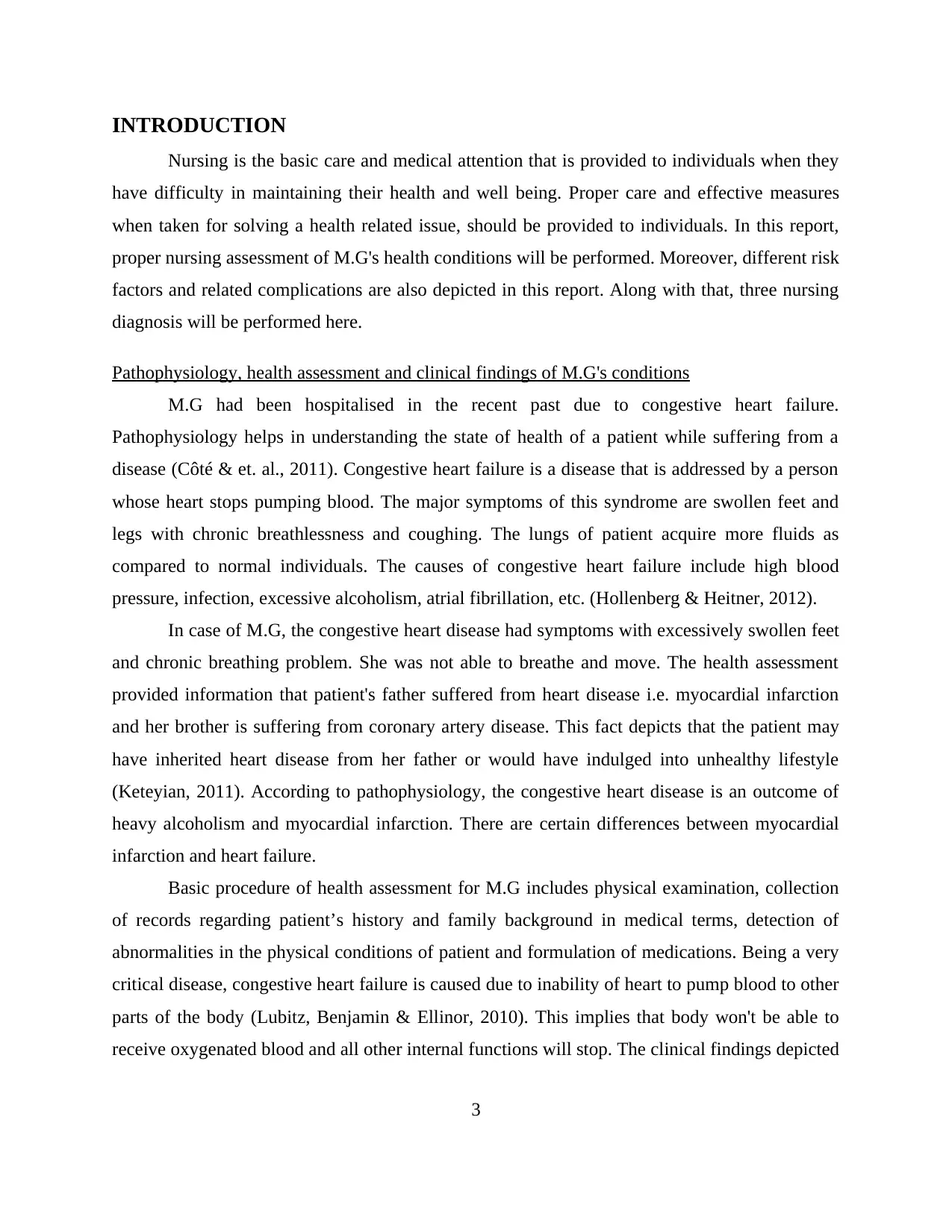
INTRODUCTION
Nursing is the basic care and medical attention that is provided to individuals when they
have difficulty in maintaining their health and well being. Proper care and effective measures
when taken for solving a health related issue, should be provided to individuals. In this report,
proper nursing assessment of M.G's health conditions will be performed. Moreover, different risk
factors and related complications are also depicted in this report. Along with that, three nursing
diagnosis will be performed here.
Pathophysiology, health assessment and clinical findings of M.G's conditions
M.G had been hospitalised in the recent past due to congestive heart failure.
Pathophysiology helps in understanding the state of health of a patient while suffering from a
disease (Côté & et. al., 2011). Congestive heart failure is a disease that is addressed by a person
whose heart stops pumping blood. The major symptoms of this syndrome are swollen feet and
legs with chronic breathlessness and coughing. The lungs of patient acquire more fluids as
compared to normal individuals. The causes of congestive heart failure include high blood
pressure, infection, excessive alcoholism, atrial fibrillation, etc. (Hollenberg & Heitner, 2012).
In case of M.G, the congestive heart disease had symptoms with excessively swollen feet
and chronic breathing problem. She was not able to breathe and move. The health assessment
provided information that patient's father suffered from heart disease i.e. myocardial infarction
and her brother is suffering from coronary artery disease. This fact depicts that the patient may
have inherited heart disease from her father or would have indulged into unhealthy lifestyle
(Keteyian, 2011). According to pathophysiology, the congestive heart disease is an outcome of
heavy alcoholism and myocardial infarction. There are certain differences between myocardial
infarction and heart failure.
Basic procedure of health assessment for M.G includes physical examination, collection
of records regarding patient’s history and family background in medical terms, detection of
abnormalities in the physical conditions of patient and formulation of medications. Being a very
critical disease, congestive heart failure is caused due to inability of heart to pump blood to other
parts of the body (Lubitz, Benjamin & Ellinor, 2010). This implies that body won't be able to
receive oxygenated blood and all other internal functions will stop. The clinical findings depicted
3
Nursing is the basic care and medical attention that is provided to individuals when they
have difficulty in maintaining their health and well being. Proper care and effective measures
when taken for solving a health related issue, should be provided to individuals. In this report,
proper nursing assessment of M.G's health conditions will be performed. Moreover, different risk
factors and related complications are also depicted in this report. Along with that, three nursing
diagnosis will be performed here.
Pathophysiology, health assessment and clinical findings of M.G's conditions
M.G had been hospitalised in the recent past due to congestive heart failure.
Pathophysiology helps in understanding the state of health of a patient while suffering from a
disease (Côté & et. al., 2011). Congestive heart failure is a disease that is addressed by a person
whose heart stops pumping blood. The major symptoms of this syndrome are swollen feet and
legs with chronic breathlessness and coughing. The lungs of patient acquire more fluids as
compared to normal individuals. The causes of congestive heart failure include high blood
pressure, infection, excessive alcoholism, atrial fibrillation, etc. (Hollenberg & Heitner, 2012).
In case of M.G, the congestive heart disease had symptoms with excessively swollen feet
and chronic breathing problem. She was not able to breathe and move. The health assessment
provided information that patient's father suffered from heart disease i.e. myocardial infarction
and her brother is suffering from coronary artery disease. This fact depicts that the patient may
have inherited heart disease from her father or would have indulged into unhealthy lifestyle
(Keteyian, 2011). According to pathophysiology, the congestive heart disease is an outcome of
heavy alcoholism and myocardial infarction. There are certain differences between myocardial
infarction and heart failure.
Basic procedure of health assessment for M.G includes physical examination, collection
of records regarding patient’s history and family background in medical terms, detection of
abnormalities in the physical conditions of patient and formulation of medications. Being a very
critical disease, congestive heart failure is caused due to inability of heart to pump blood to other
parts of the body (Lubitz, Benjamin & Ellinor, 2010). This implies that body won't be able to
receive oxygenated blood and all other internal functions will stop. The clinical findings depicted
3
⊘ This is a preview!⊘
Do you want full access?
Subscribe today to unlock all pages.

Trusted by 1+ million students worldwide
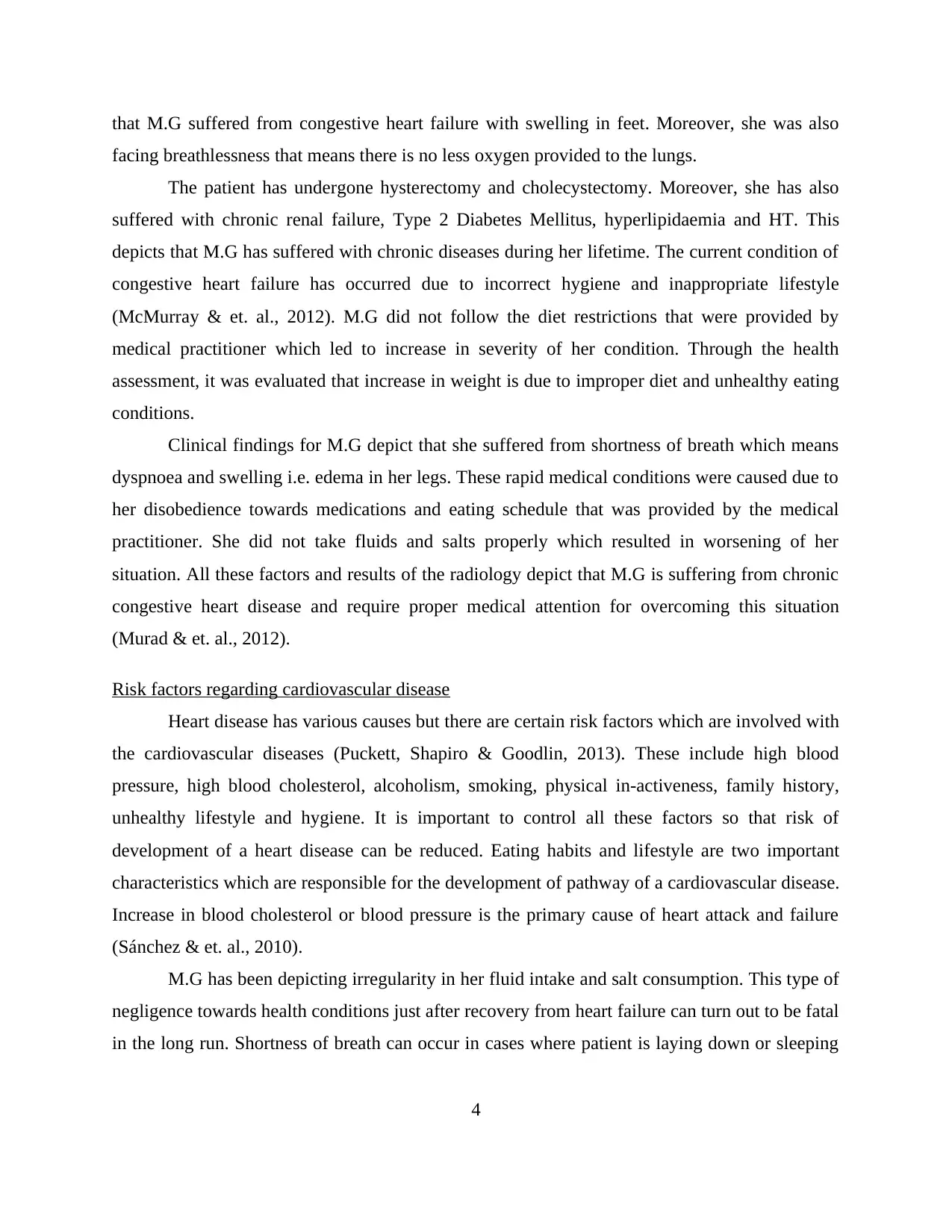
that M.G suffered from congestive heart failure with swelling in feet. Moreover, she was also
facing breathlessness that means there is no less oxygen provided to the lungs.
The patient has undergone hysterectomy and cholecystectomy. Moreover, she has also
suffered with chronic renal failure, Type 2 Diabetes Mellitus, hyperlipidaemia and HT. This
depicts that M.G has suffered with chronic diseases during her lifetime. The current condition of
congestive heart failure has occurred due to incorrect hygiene and inappropriate lifestyle
(McMurray & et. al., 2012). M.G did not follow the diet restrictions that were provided by
medical practitioner which led to increase in severity of her condition. Through the health
assessment, it was evaluated that increase in weight is due to improper diet and unhealthy eating
conditions.
Clinical findings for M.G depict that she suffered from shortness of breath which means
dyspnoea and swelling i.e. edema in her legs. These rapid medical conditions were caused due to
her disobedience towards medications and eating schedule that was provided by the medical
practitioner. She did not take fluids and salts properly which resulted in worsening of her
situation. All these factors and results of the radiology depict that M.G is suffering from chronic
congestive heart disease and require proper medical attention for overcoming this situation
(Murad & et. al., 2012).
Risk factors regarding cardiovascular disease
Heart disease has various causes but there are certain risk factors which are involved with
the cardiovascular diseases (Puckett, Shapiro & Goodlin, 2013). These include high blood
pressure, high blood cholesterol, alcoholism, smoking, physical in-activeness, family history,
unhealthy lifestyle and hygiene. It is important to control all these factors so that risk of
development of a heart disease can be reduced. Eating habits and lifestyle are two important
characteristics which are responsible for the development of pathway of a cardiovascular disease.
Increase in blood cholesterol or blood pressure is the primary cause of heart attack and failure
(Sánchez & et. al., 2010).
M.G has been depicting irregularity in her fluid intake and salt consumption. This type of
negligence towards health conditions just after recovery from heart failure can turn out to be fatal
in the long run. Shortness of breath can occur in cases where patient is laying down or sleeping
4
facing breathlessness that means there is no less oxygen provided to the lungs.
The patient has undergone hysterectomy and cholecystectomy. Moreover, she has also
suffered with chronic renal failure, Type 2 Diabetes Mellitus, hyperlipidaemia and HT. This
depicts that M.G has suffered with chronic diseases during her lifetime. The current condition of
congestive heart failure has occurred due to incorrect hygiene and inappropriate lifestyle
(McMurray & et. al., 2012). M.G did not follow the diet restrictions that were provided by
medical practitioner which led to increase in severity of her condition. Through the health
assessment, it was evaluated that increase in weight is due to improper diet and unhealthy eating
conditions.
Clinical findings for M.G depict that she suffered from shortness of breath which means
dyspnoea and swelling i.e. edema in her legs. These rapid medical conditions were caused due to
her disobedience towards medications and eating schedule that was provided by the medical
practitioner. She did not take fluids and salts properly which resulted in worsening of her
situation. All these factors and results of the radiology depict that M.G is suffering from chronic
congestive heart disease and require proper medical attention for overcoming this situation
(Murad & et. al., 2012).
Risk factors regarding cardiovascular disease
Heart disease has various causes but there are certain risk factors which are involved with
the cardiovascular diseases (Puckett, Shapiro & Goodlin, 2013). These include high blood
pressure, high blood cholesterol, alcoholism, smoking, physical in-activeness, family history,
unhealthy lifestyle and hygiene. It is important to control all these factors so that risk of
development of a heart disease can be reduced. Eating habits and lifestyle are two important
characteristics which are responsible for the development of pathway of a cardiovascular disease.
Increase in blood cholesterol or blood pressure is the primary cause of heart attack and failure
(Sánchez & et. al., 2010).
M.G has been depicting irregularity in her fluid intake and salt consumption. This type of
negligence towards health conditions just after recovery from heart failure can turn out to be fatal
in the long run. Shortness of breath can occur in cases where patient is laying down or sleeping
4
Paraphrase This Document
Need a fresh take? Get an instant paraphrase of this document with our AI Paraphraser
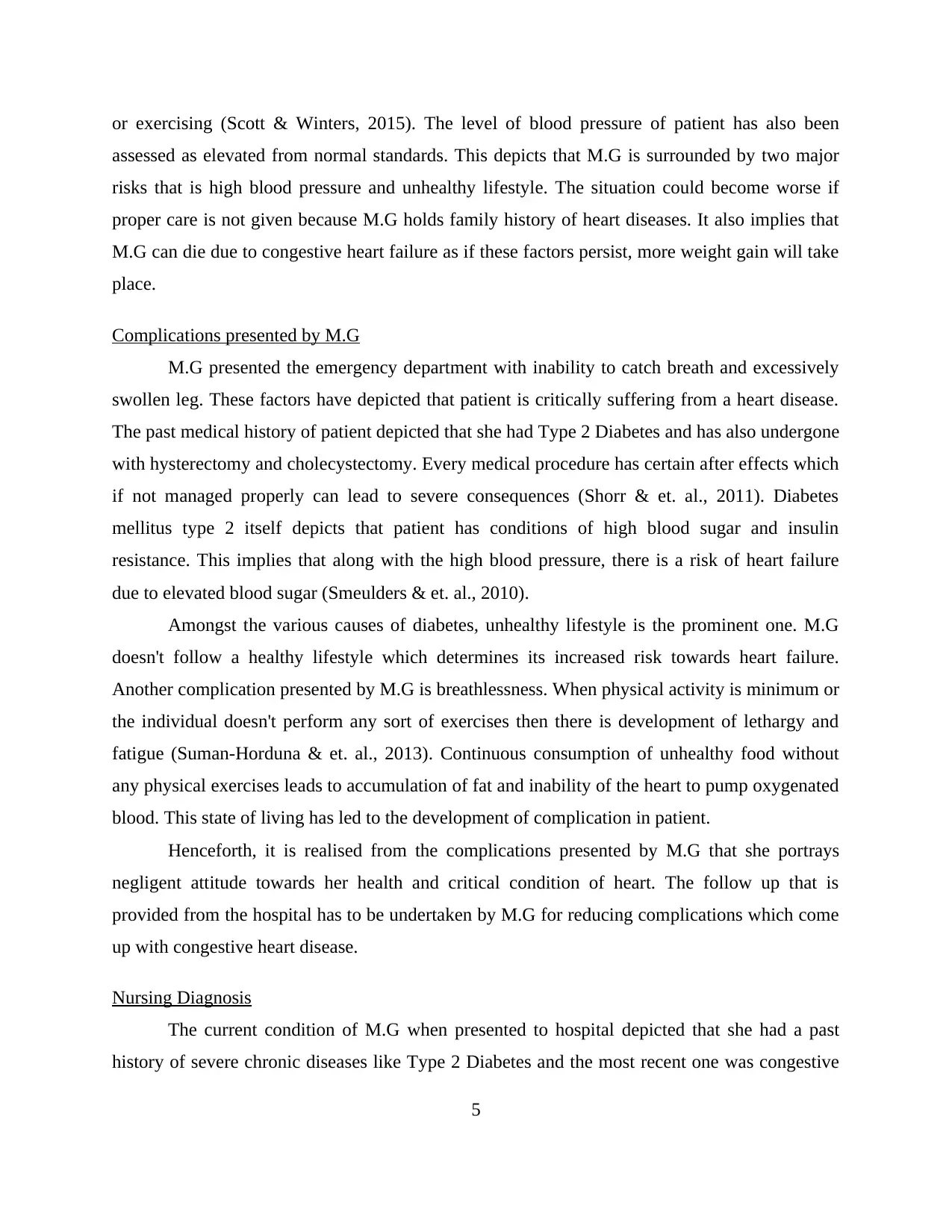
or exercising (Scott & Winters, 2015). The level of blood pressure of patient has also been
assessed as elevated from normal standards. This depicts that M.G is surrounded by two major
risks that is high blood pressure and unhealthy lifestyle. The situation could become worse if
proper care is not given because M.G holds family history of heart diseases. It also implies that
M.G can die due to congestive heart failure as if these factors persist, more weight gain will take
place.
Complications presented by M.G
M.G presented the emergency department with inability to catch breath and excessively
swollen leg. These factors have depicted that patient is critically suffering from a heart disease.
The past medical history of patient depicted that she had Type 2 Diabetes and has also undergone
with hysterectomy and cholecystectomy. Every medical procedure has certain after effects which
if not managed properly can lead to severe consequences (Shorr & et. al., 2011). Diabetes
mellitus type 2 itself depicts that patient has conditions of high blood sugar and insulin
resistance. This implies that along with the high blood pressure, there is a risk of heart failure
due to elevated blood sugar (Smeulders & et. al., 2010).
Amongst the various causes of diabetes, unhealthy lifestyle is the prominent one. M.G
doesn't follow a healthy lifestyle which determines its increased risk towards heart failure.
Another complication presented by M.G is breathlessness. When physical activity is minimum or
the individual doesn't perform any sort of exercises then there is development of lethargy and
fatigue (Suman-Horduna & et. al., 2013). Continuous consumption of unhealthy food without
any physical exercises leads to accumulation of fat and inability of the heart to pump oxygenated
blood. This state of living has led to the development of complication in patient.
Henceforth, it is realised from the complications presented by M.G that she portrays
negligent attitude towards her health and critical condition of heart. The follow up that is
provided from the hospital has to be undertaken by M.G for reducing complications which come
up with congestive heart disease.
Nursing Diagnosis
The current condition of M.G when presented to hospital depicted that she had a past
history of severe chronic diseases like Type 2 Diabetes and the most recent one was congestive
5
assessed as elevated from normal standards. This depicts that M.G is surrounded by two major
risks that is high blood pressure and unhealthy lifestyle. The situation could become worse if
proper care is not given because M.G holds family history of heart diseases. It also implies that
M.G can die due to congestive heart failure as if these factors persist, more weight gain will take
place.
Complications presented by M.G
M.G presented the emergency department with inability to catch breath and excessively
swollen leg. These factors have depicted that patient is critically suffering from a heart disease.
The past medical history of patient depicted that she had Type 2 Diabetes and has also undergone
with hysterectomy and cholecystectomy. Every medical procedure has certain after effects which
if not managed properly can lead to severe consequences (Shorr & et. al., 2011). Diabetes
mellitus type 2 itself depicts that patient has conditions of high blood sugar and insulin
resistance. This implies that along with the high blood pressure, there is a risk of heart failure
due to elevated blood sugar (Smeulders & et. al., 2010).
Amongst the various causes of diabetes, unhealthy lifestyle is the prominent one. M.G
doesn't follow a healthy lifestyle which determines its increased risk towards heart failure.
Another complication presented by M.G is breathlessness. When physical activity is minimum or
the individual doesn't perform any sort of exercises then there is development of lethargy and
fatigue (Suman-Horduna & et. al., 2013). Continuous consumption of unhealthy food without
any physical exercises leads to accumulation of fat and inability of the heart to pump oxygenated
blood. This state of living has led to the development of complication in patient.
Henceforth, it is realised from the complications presented by M.G that she portrays
negligent attitude towards her health and critical condition of heart. The follow up that is
provided from the hospital has to be undertaken by M.G for reducing complications which come
up with congestive heart disease.
Nursing Diagnosis
The current condition of M.G when presented to hospital depicted that she had a past
history of severe chronic diseases like Type 2 Diabetes and the most recent one was congestive
5
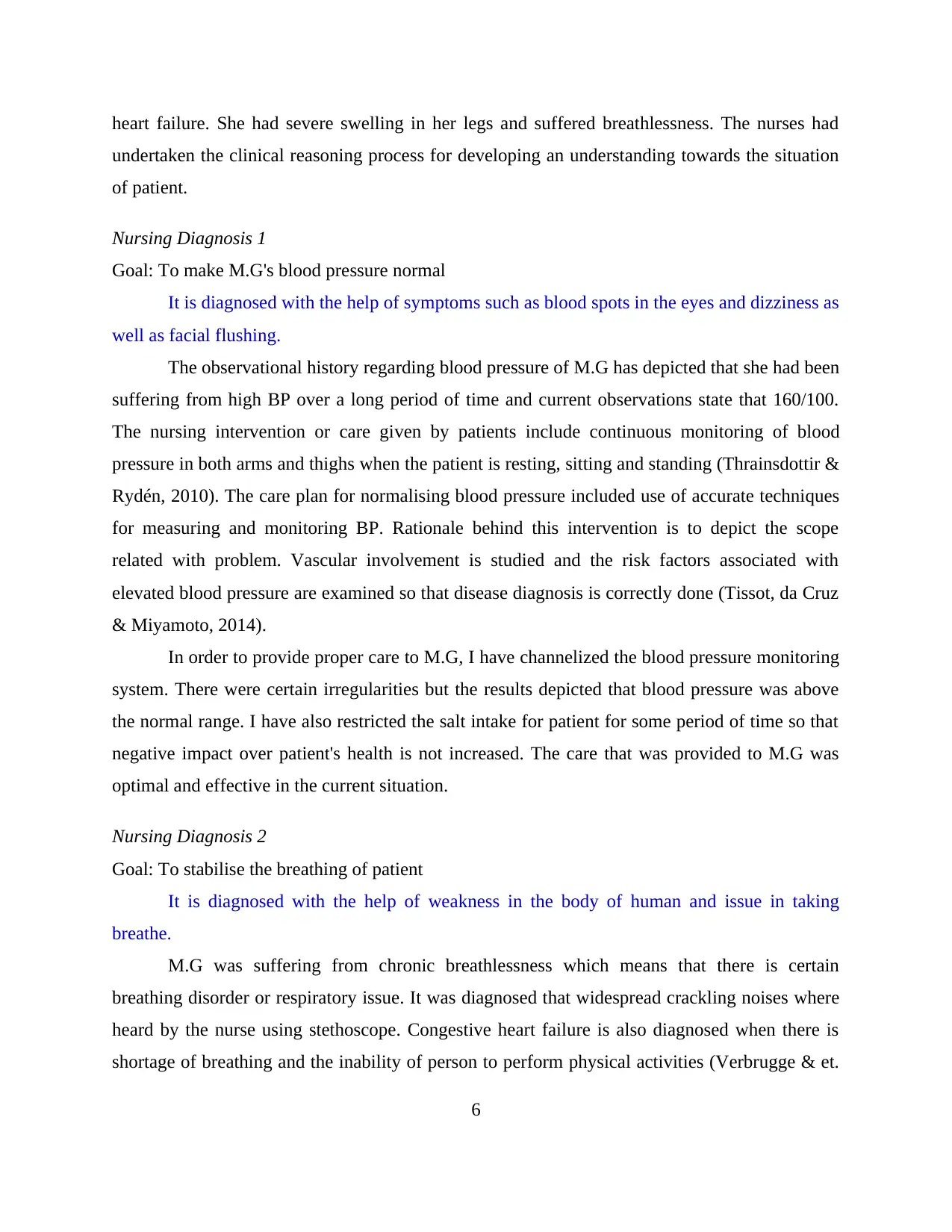
heart failure. She had severe swelling in her legs and suffered breathlessness. The nurses had
undertaken the clinical reasoning process for developing an understanding towards the situation
of patient.
Nursing Diagnosis 1
Goal: To make M.G's blood pressure normal
It is diagnosed with the help of symptoms such as blood spots in the eyes and dizziness as
well as facial flushing.
The observational history regarding blood pressure of M.G has depicted that she had been
suffering from high BP over a long period of time and current observations state that 160/100.
The nursing intervention or care given by patients include continuous monitoring of blood
pressure in both arms and thighs when the patient is resting, sitting and standing (Thrainsdottir &
Rydén, 2010). The care plan for normalising blood pressure included use of accurate techniques
for measuring and monitoring BP. Rationale behind this intervention is to depict the scope
related with problem. Vascular involvement is studied and the risk factors associated with
elevated blood pressure are examined so that disease diagnosis is correctly done (Tissot, da Cruz
& Miyamoto, 2014).
In order to provide proper care to M.G, I have channelized the blood pressure monitoring
system. There were certain irregularities but the results depicted that blood pressure was above
the normal range. I have also restricted the salt intake for patient for some period of time so that
negative impact over patient's health is not increased. The care that was provided to M.G was
optimal and effective in the current situation.
Nursing Diagnosis 2
Goal: To stabilise the breathing of patient
It is diagnosed with the help of weakness in the body of human and issue in taking
breathe.
M.G was suffering from chronic breathlessness which means that there is certain
breathing disorder or respiratory issue. It was diagnosed that widespread crackling noises where
heard by the nurse using stethoscope. Congestive heart failure is also diagnosed when there is
shortage of breathing and the inability of person to perform physical activities (Verbrugge & et.
6
undertaken the clinical reasoning process for developing an understanding towards the situation
of patient.
Nursing Diagnosis 1
Goal: To make M.G's blood pressure normal
It is diagnosed with the help of symptoms such as blood spots in the eyes and dizziness as
well as facial flushing.
The observational history regarding blood pressure of M.G has depicted that she had been
suffering from high BP over a long period of time and current observations state that 160/100.
The nursing intervention or care given by patients include continuous monitoring of blood
pressure in both arms and thighs when the patient is resting, sitting and standing (Thrainsdottir &
Rydén, 2010). The care plan for normalising blood pressure included use of accurate techniques
for measuring and monitoring BP. Rationale behind this intervention is to depict the scope
related with problem. Vascular involvement is studied and the risk factors associated with
elevated blood pressure are examined so that disease diagnosis is correctly done (Tissot, da Cruz
& Miyamoto, 2014).
In order to provide proper care to M.G, I have channelized the blood pressure monitoring
system. There were certain irregularities but the results depicted that blood pressure was above
the normal range. I have also restricted the salt intake for patient for some period of time so that
negative impact over patient's health is not increased. The care that was provided to M.G was
optimal and effective in the current situation.
Nursing Diagnosis 2
Goal: To stabilise the breathing of patient
It is diagnosed with the help of weakness in the body of human and issue in taking
breathe.
M.G was suffering from chronic breathlessness which means that there is certain
breathing disorder or respiratory issue. It was diagnosed that widespread crackling noises where
heard by the nurse using stethoscope. Congestive heart failure is also diagnosed when there is
shortage of breathing and the inability of person to perform physical activities (Verbrugge & et.
6
⊘ This is a preview!⊘
Do you want full access?
Subscribe today to unlock all pages.

Trusted by 1+ million students worldwide
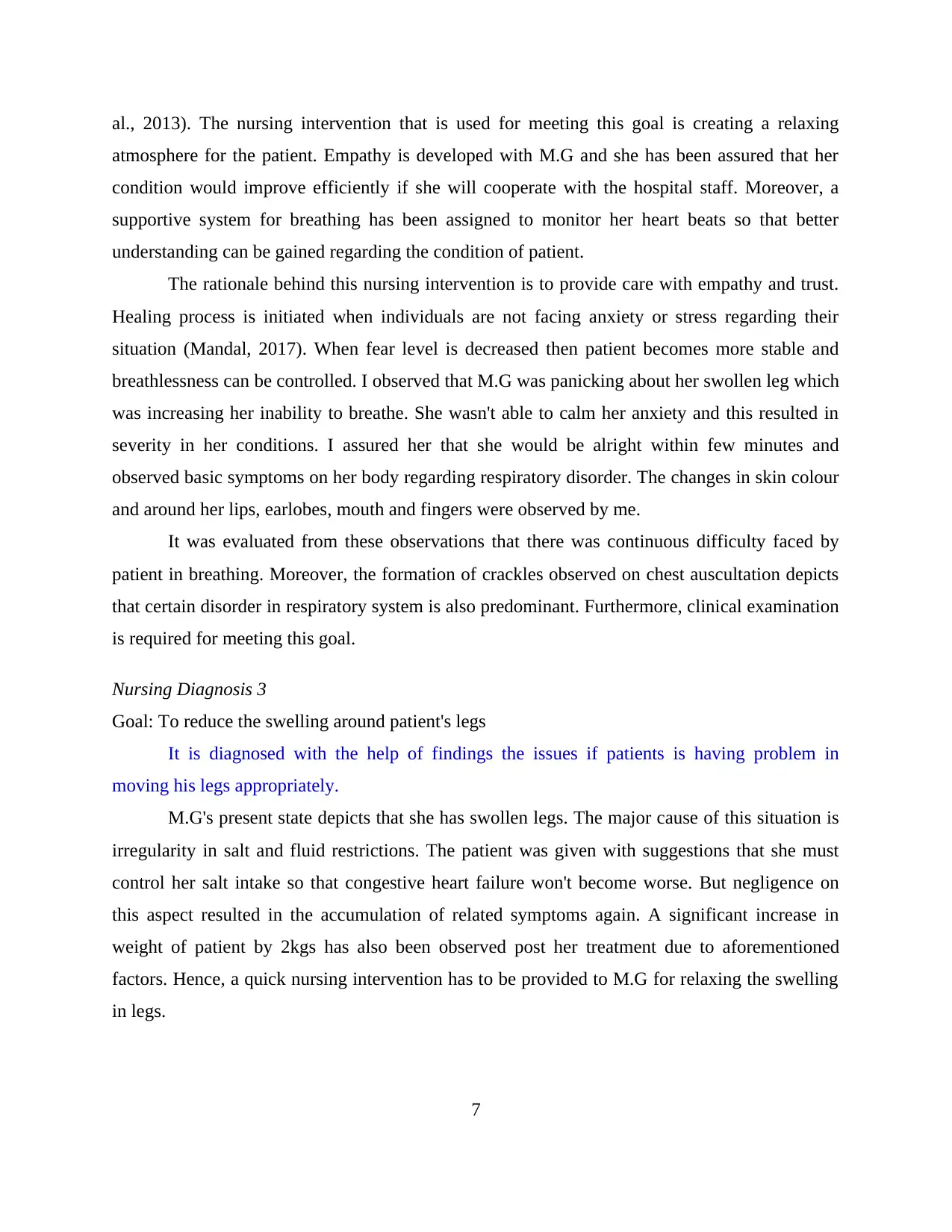
al., 2013). The nursing intervention that is used for meeting this goal is creating a relaxing
atmosphere for the patient. Empathy is developed with M.G and she has been assured that her
condition would improve efficiently if she will cooperate with the hospital staff. Moreover, a
supportive system for breathing has been assigned to monitor her heart beats so that better
understanding can be gained regarding the condition of patient.
The rationale behind this nursing intervention is to provide care with empathy and trust.
Healing process is initiated when individuals are not facing anxiety or stress regarding their
situation (Mandal, 2017). When fear level is decreased then patient becomes more stable and
breathlessness can be controlled. I observed that M.G was panicking about her swollen leg which
was increasing her inability to breathe. She wasn't able to calm her anxiety and this resulted in
severity in her conditions. I assured her that she would be alright within few minutes and
observed basic symptoms on her body regarding respiratory disorder. The changes in skin colour
and around her lips, earlobes, mouth and fingers were observed by me.
It was evaluated from these observations that there was continuous difficulty faced by
patient in breathing. Moreover, the formation of crackles observed on chest auscultation depicts
that certain disorder in respiratory system is also predominant. Furthermore, clinical examination
is required for meeting this goal.
Nursing Diagnosis 3
Goal: To reduce the swelling around patient's legs
It is diagnosed with the help of findings the issues if patients is having problem in
moving his legs appropriately.
M.G's present state depicts that she has swollen legs. The major cause of this situation is
irregularity in salt and fluid restrictions. The patient was given with suggestions that she must
control her salt intake so that congestive heart failure won't become worse. But negligence on
this aspect resulted in the accumulation of related symptoms again. A significant increase in
weight of patient by 2kgs has also been observed post her treatment due to aforementioned
factors. Hence, a quick nursing intervention has to be provided to M.G for relaxing the swelling
in legs.
7
atmosphere for the patient. Empathy is developed with M.G and she has been assured that her
condition would improve efficiently if she will cooperate with the hospital staff. Moreover, a
supportive system for breathing has been assigned to monitor her heart beats so that better
understanding can be gained regarding the condition of patient.
The rationale behind this nursing intervention is to provide care with empathy and trust.
Healing process is initiated when individuals are not facing anxiety or stress regarding their
situation (Mandal, 2017). When fear level is decreased then patient becomes more stable and
breathlessness can be controlled. I observed that M.G was panicking about her swollen leg which
was increasing her inability to breathe. She wasn't able to calm her anxiety and this resulted in
severity in her conditions. I assured her that she would be alright within few minutes and
observed basic symptoms on her body regarding respiratory disorder. The changes in skin colour
and around her lips, earlobes, mouth and fingers were observed by me.
It was evaluated from these observations that there was continuous difficulty faced by
patient in breathing. Moreover, the formation of crackles observed on chest auscultation depicts
that certain disorder in respiratory system is also predominant. Furthermore, clinical examination
is required for meeting this goal.
Nursing Diagnosis 3
Goal: To reduce the swelling around patient's legs
It is diagnosed with the help of findings the issues if patients is having problem in
moving his legs appropriately.
M.G's present state depicts that she has swollen legs. The major cause of this situation is
irregularity in salt and fluid restrictions. The patient was given with suggestions that she must
control her salt intake so that congestive heart failure won't become worse. But negligence on
this aspect resulted in the accumulation of related symptoms again. A significant increase in
weight of patient by 2kgs has also been observed post her treatment due to aforementioned
factors. Hence, a quick nursing intervention has to be provided to M.G for relaxing the swelling
in legs.
7
Paraphrase This Document
Need a fresh take? Get an instant paraphrase of this document with our AI Paraphraser
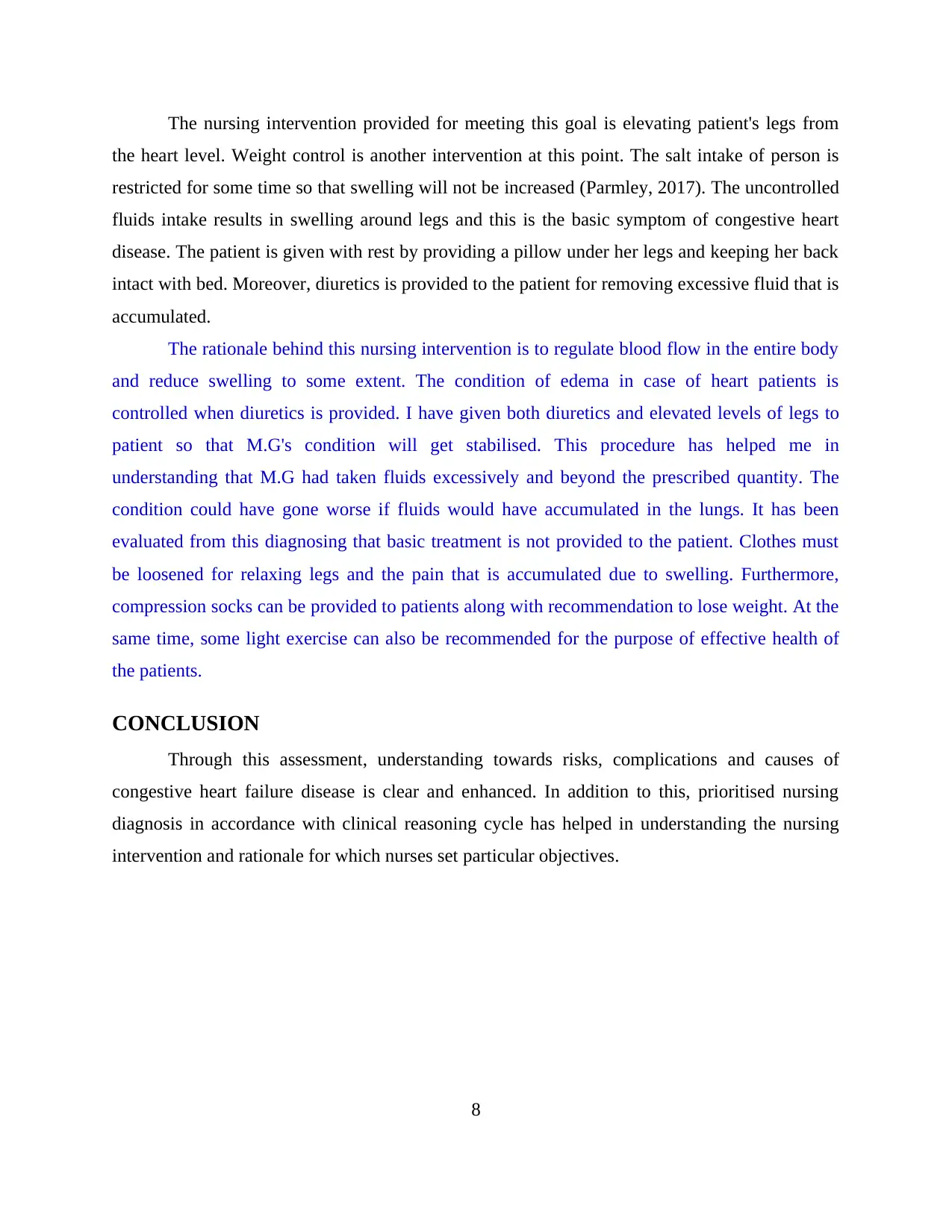
The nursing intervention provided for meeting this goal is elevating patient's legs from
the heart level. Weight control is another intervention at this point. The salt intake of person is
restricted for some time so that swelling will not be increased (Parmley, 2017). The uncontrolled
fluids intake results in swelling around legs and this is the basic symptom of congestive heart
disease. The patient is given with rest by providing a pillow under her legs and keeping her back
intact with bed. Moreover, diuretics is provided to the patient for removing excessive fluid that is
accumulated.
The rationale behind this nursing intervention is to regulate blood flow in the entire body
and reduce swelling to some extent. The condition of edema in case of heart patients is
controlled when diuretics is provided. I have given both diuretics and elevated levels of legs to
patient so that M.G's condition will get stabilised. This procedure has helped me in
understanding that M.G had taken fluids excessively and beyond the prescribed quantity. The
condition could have gone worse if fluids would have accumulated in the lungs. It has been
evaluated from this diagnosing that basic treatment is not provided to the patient. Clothes must
be loosened for relaxing legs and the pain that is accumulated due to swelling. Furthermore,
compression socks can be provided to patients along with recommendation to lose weight. At the
same time, some light exercise can also be recommended for the purpose of effective health of
the patients.
CONCLUSION
Through this assessment, understanding towards risks, complications and causes of
congestive heart failure disease is clear and enhanced. In addition to this, prioritised nursing
diagnosis in accordance with clinical reasoning cycle has helped in understanding the nursing
intervention and rationale for which nurses set particular objectives.
8
the heart level. Weight control is another intervention at this point. The salt intake of person is
restricted for some time so that swelling will not be increased (Parmley, 2017). The uncontrolled
fluids intake results in swelling around legs and this is the basic symptom of congestive heart
disease. The patient is given with rest by providing a pillow under her legs and keeping her back
intact with bed. Moreover, diuretics is provided to the patient for removing excessive fluid that is
accumulated.
The rationale behind this nursing intervention is to regulate blood flow in the entire body
and reduce swelling to some extent. The condition of edema in case of heart patients is
controlled when diuretics is provided. I have given both diuretics and elevated levels of legs to
patient so that M.G's condition will get stabilised. This procedure has helped me in
understanding that M.G had taken fluids excessively and beyond the prescribed quantity. The
condition could have gone worse if fluids would have accumulated in the lungs. It has been
evaluated from this diagnosing that basic treatment is not provided to the patient. Clothes must
be loosened for relaxing legs and the pain that is accumulated due to swelling. Furthermore,
compression socks can be provided to patients along with recommendation to lose weight. At the
same time, some light exercise can also be recommended for the purpose of effective health of
the patients.
CONCLUSION
Through this assessment, understanding towards risks, complications and causes of
congestive heart failure disease is clear and enhanced. In addition to this, prioritised nursing
diagnosis in accordance with clinical reasoning cycle has helped in understanding the nursing
intervention and rationale for which nurses set particular objectives.
8
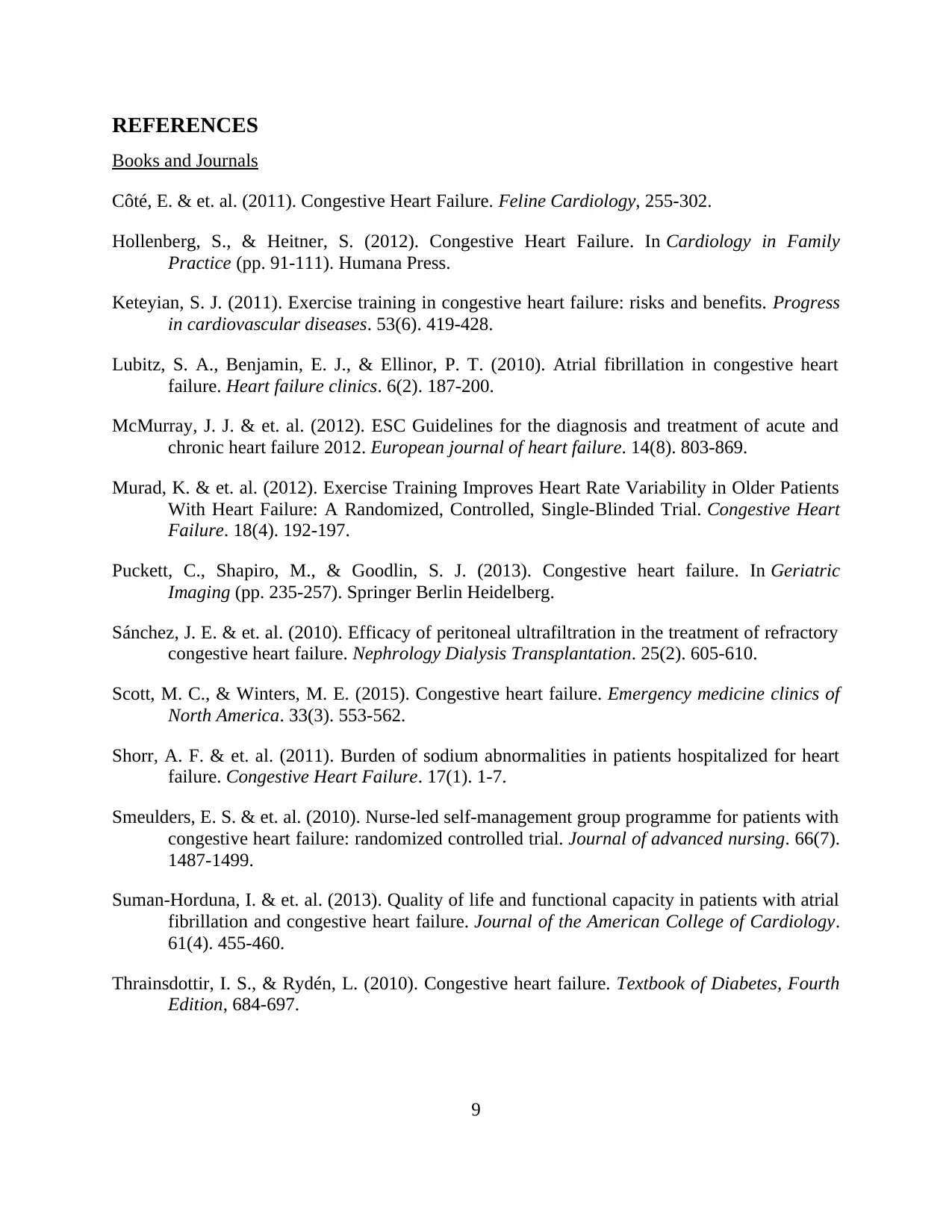
REFERENCES
Books and Journals
Côté, E. & et. al. (2011). Congestive Heart Failure. Feline Cardiology, 255-302.
Hollenberg, S., & Heitner, S. (2012). Congestive Heart Failure. In Cardiology in Family
Practice (pp. 91-111). Humana Press.
Keteyian, S. J. (2011). Exercise training in congestive heart failure: risks and benefits. Progress
in cardiovascular diseases. 53(6). 419-428.
Lubitz, S. A., Benjamin, E. J., & Ellinor, P. T. (2010). Atrial fibrillation in congestive heart
failure. Heart failure clinics. 6(2). 187-200.
McMurray, J. J. & et. al. (2012). ESC Guidelines for the diagnosis and treatment of acute and
chronic heart failure 2012. European journal of heart failure. 14(8). 803-869.
Murad, K. & et. al. (2012). Exercise Training Improves Heart Rate Variability in Older Patients
With Heart Failure: A Randomized, Controlled, Single‐Blinded Trial. Congestive Heart
Failure. 18(4). 192-197.
Puckett, C., Shapiro, M., & Goodlin, S. J. (2013). Congestive heart failure. In Geriatric
Imaging (pp. 235-257). Springer Berlin Heidelberg.
Sánchez, J. E. & et. al. (2010). Efficacy of peritoneal ultrafiltration in the treatment of refractory
congestive heart failure. Nephrology Dialysis Transplantation. 25(2). 605-610.
Scott, M. C., & Winters, M. E. (2015). Congestive heart failure. Emergency medicine clinics of
North America. 33(3). 553-562.
Shorr, A. F. & et. al. (2011). Burden of sodium abnormalities in patients hospitalized for heart
failure. Congestive Heart Failure. 17(1). 1-7.
Smeulders, E. S. & et. al. (2010). Nurse‐led self‐management group programme for patients with
congestive heart failure: randomized controlled trial. Journal of advanced nursing. 66(7).
1487-1499.
Suman-Horduna, I. & et. al. (2013). Quality of life and functional capacity in patients with atrial
fibrillation and congestive heart failure. Journal of the American College of Cardiology.
61(4). 455-460.
Thrainsdottir, I. S., & Rydén, L. (2010). Congestive heart failure. Textbook of Diabetes, Fourth
Edition, 684-697.
9
Books and Journals
Côté, E. & et. al. (2011). Congestive Heart Failure. Feline Cardiology, 255-302.
Hollenberg, S., & Heitner, S. (2012). Congestive Heart Failure. In Cardiology in Family
Practice (pp. 91-111). Humana Press.
Keteyian, S. J. (2011). Exercise training in congestive heart failure: risks and benefits. Progress
in cardiovascular diseases. 53(6). 419-428.
Lubitz, S. A., Benjamin, E. J., & Ellinor, P. T. (2010). Atrial fibrillation in congestive heart
failure. Heart failure clinics. 6(2). 187-200.
McMurray, J. J. & et. al. (2012). ESC Guidelines for the diagnosis and treatment of acute and
chronic heart failure 2012. European journal of heart failure. 14(8). 803-869.
Murad, K. & et. al. (2012). Exercise Training Improves Heart Rate Variability in Older Patients
With Heart Failure: A Randomized, Controlled, Single‐Blinded Trial. Congestive Heart
Failure. 18(4). 192-197.
Puckett, C., Shapiro, M., & Goodlin, S. J. (2013). Congestive heart failure. In Geriatric
Imaging (pp. 235-257). Springer Berlin Heidelberg.
Sánchez, J. E. & et. al. (2010). Efficacy of peritoneal ultrafiltration in the treatment of refractory
congestive heart failure. Nephrology Dialysis Transplantation. 25(2). 605-610.
Scott, M. C., & Winters, M. E. (2015). Congestive heart failure. Emergency medicine clinics of
North America. 33(3). 553-562.
Shorr, A. F. & et. al. (2011). Burden of sodium abnormalities in patients hospitalized for heart
failure. Congestive Heart Failure. 17(1). 1-7.
Smeulders, E. S. & et. al. (2010). Nurse‐led self‐management group programme for patients with
congestive heart failure: randomized controlled trial. Journal of advanced nursing. 66(7).
1487-1499.
Suman-Horduna, I. & et. al. (2013). Quality of life and functional capacity in patients with atrial
fibrillation and congestive heart failure. Journal of the American College of Cardiology.
61(4). 455-460.
Thrainsdottir, I. S., & Rydén, L. (2010). Congestive heart failure. Textbook of Diabetes, Fourth
Edition, 684-697.
9
⊘ This is a preview!⊘
Do you want full access?
Subscribe today to unlock all pages.

Trusted by 1+ million students worldwide
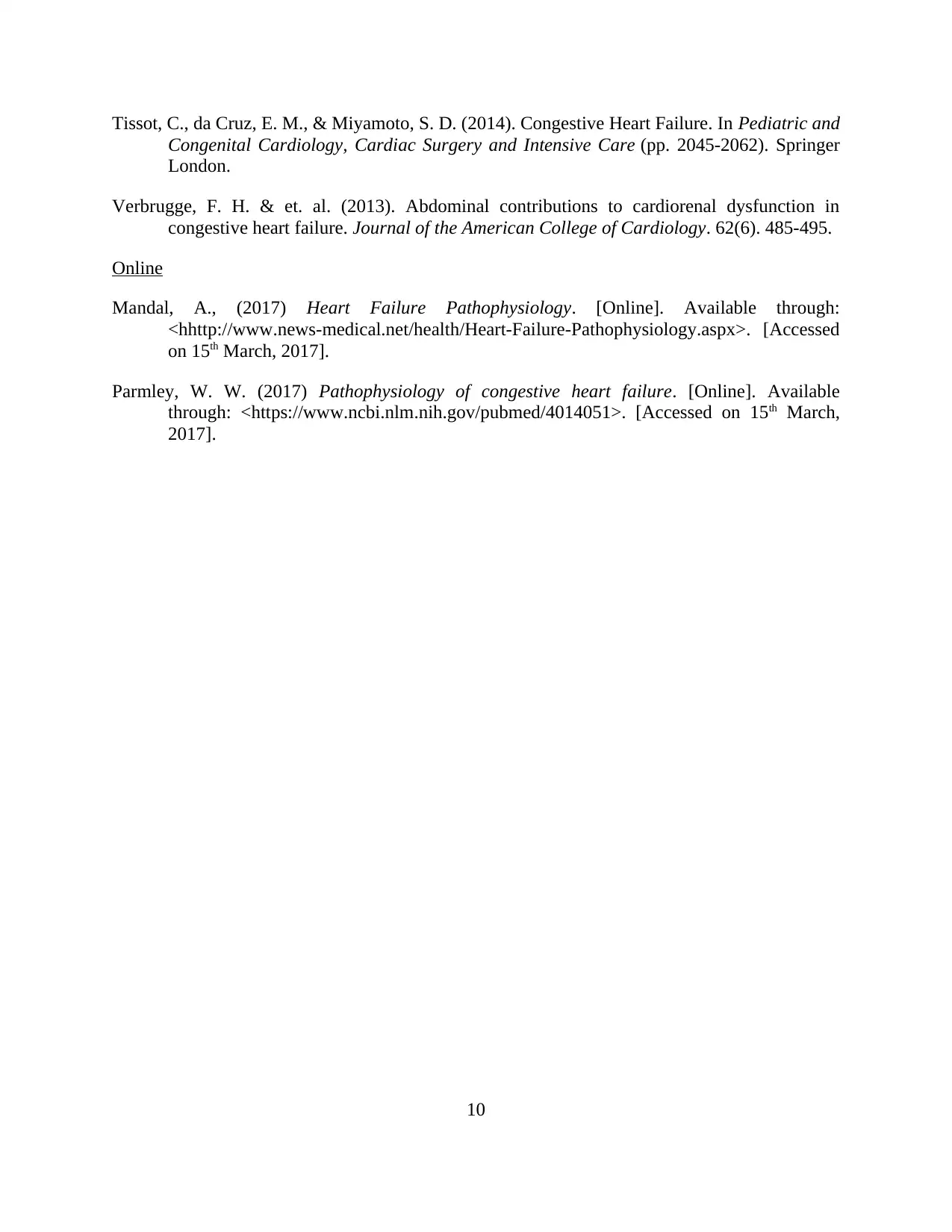
Tissot, C., da Cruz, E. M., & Miyamoto, S. D. (2014). Congestive Heart Failure. In Pediatric and
Congenital Cardiology, Cardiac Surgery and Intensive Care (pp. 2045-2062). Springer
London.
Verbrugge, F. H. & et. al. (2013). Abdominal contributions to cardiorenal dysfunction in
congestive heart failure. Journal of the American College of Cardiology. 62(6). 485-495.
Online
Mandal, A., (2017) Heart Failure Pathophysiology. [Online]. Available through:
<hhttp://www.news-medical.net/health/Heart-Failure-Pathophysiology.aspx>. [Accessed
on 15th March, 2017].
Parmley, W. W. (2017) Pathophysiology of congestive heart failure. [Online]. Available
through: <https://www.ncbi.nlm.nih.gov/pubmed/4014051>. [Accessed on 15th March,
2017].
10
Congenital Cardiology, Cardiac Surgery and Intensive Care (pp. 2045-2062). Springer
London.
Verbrugge, F. H. & et. al. (2013). Abdominal contributions to cardiorenal dysfunction in
congestive heart failure. Journal of the American College of Cardiology. 62(6). 485-495.
Online
Mandal, A., (2017) Heart Failure Pathophysiology. [Online]. Available through:
<hhttp://www.news-medical.net/health/Heart-Failure-Pathophysiology.aspx>. [Accessed
on 15th March, 2017].
Parmley, W. W. (2017) Pathophysiology of congestive heart failure. [Online]. Available
through: <https://www.ncbi.nlm.nih.gov/pubmed/4014051>. [Accessed on 15th March,
2017].
10
Paraphrase This Document
Need a fresh take? Get an instant paraphrase of this document with our AI Paraphraser

1 out of 11
Related Documents
Your All-in-One AI-Powered Toolkit for Academic Success.
+13062052269
info@desklib.com
Available 24*7 on WhatsApp / Email
![[object Object]](/_next/static/media/star-bottom.7253800d.svg)
Unlock your academic potential
Copyright © 2020–2025 A2Z Services. All Rights Reserved. Developed and managed by ZUCOL.





